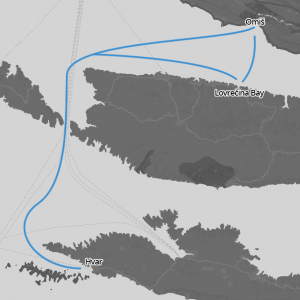Sightsee the old town of Hvar and experience the beauty of Blue Lagoon with all your senses.
Hvar belongs to a group of Middle Dalmatia Islands. With an annual average of 2726 hours of sun, it is considered the sunniest Croatian island. Recognizable for its numerous bays, some of which completely inhibited, and some reachable only by the sea. Larger centers on the island
are Hvar town, Stari Grad and Jelsa.
Name of the island comes from the Greek colony called “Pharos”; however, it is important to know that traces of life on the island of Hvar goes back to the Neolithic period. In Roman times, villas and agricultural estates were built on the island, that resulted in a long tradition of viticulture, but
also the high culture of residence.
Hvar has been known as the island of lavender for centuries – and with good reason, too! Lavender grows all over the island, providing a beautiful contrast of purple with the azure sea, along with a fragrance that cannot be found anywhere else.
The port of Hvar, set in a picturesque natural bay, with the Pakleni Otoci island chain protecting it to the south, is a haven for boats year-round. The city is a popular port of call for yachts sailing around the Adriatic, especially in the summer months.
Hvar town is a protected Cultural Heritage area, as are the rural areas of Velo Grablje, Malo Grablje, and Zaraće. In addition, there are five archaeological sites in the area: the hydro-archaeological site of Palmižana, villa Rustica Soline, the prehistoric site of Vira, and the prehistoric Lompić fort in the Gračišće Bay.
Either you decide to wander around old stone streets visiting architectural attractions; hang in cafe’s absorbing the sun; enjoying the beautiful view on this jewel hidden by the time; or taste Dalmatian gastronomical offer in the best restaurants you’ll have a memorable experience.
Sightseeing of town Hvar
Name of the island comes from the Greek colony called “Pharos”, however, it is important to know that traces of life on the island of Hvar goes back to the Neolithic period. In Roman times on the island were built villas and agricultural estates, which resulted in a long tradition of viticulture, but also the high culture of residence. Hvar is called the island of lavender since that plant grows here in abundance, as well as rosemary and sage.
Either you decide to wonder around old stone streets visiting architectural attractions, hang in cafe’s absorbing the sun and enjoying the beautiful view on this jewel hidden by the time or taste Dalmatian gastronomical offer in the best restaurants you’ll have a memorable experience.




